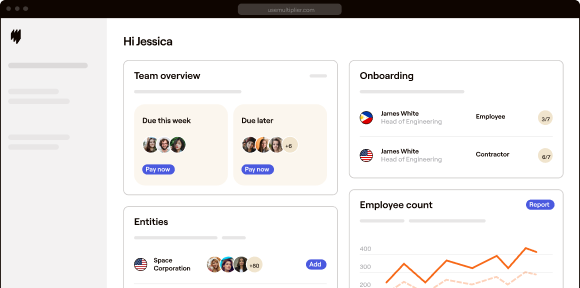The global freelance economy is booming, with contractor payments becoming a critical strategic consideration for businesses.
With freelancers now making up 46.6% of the global workforce (approximately 1.57 billion individuals), efficient and compliant payment solutions are no longer a luxury but a necessity.
Choosing the right contractor payment method directly impacts your operational costs, legal compliance, and ability to retain top talent. This guide offers the seven best ways to manage your international contractor payments effectively.
Why contractor payments matter for your business
The choice of the optimal contractor payment method should be evaluated not just for convenience, but also for its impact on cost efficiency, legal compliance, and contractor satisfaction.
Cost efficiency and compliance
As per Global Workplace Analytics, companies in the US save an estimated $10,600 to $11,000 annually per remote worker through reduced office expenses. These savings come from lower costs for rent, utilities, office supplies, furniture, and maintenance. For example, businesses can downsize office spaces or eliminate them entirely, reducing real estate costs significantly – similar to how IBM saved $50 million on real estate with a remote workforce. Additional savings include reduced expenses for snacks, coffee, cleaning, and security services. For a company with 50 remote employees, this could translate to savings of up to $500,000 per year.
However, these savings can quickly be offset if contractor payments are not handled properly — particularly when it comes to classification and tax compliance.
Contractor misclassification is one of the costliest mistakes businesses can make when hiring internationally. If you’re paying contractors using methods that resemble employee payroll (e.g., fixed monthly salaries, benefits, or control over work hours), you risk violating local labor laws.
Here’s what that could cost:
- IRS penalties: $50 per missing W-2, plus 1.5% of wages
- California’s AB5 law: Fines up to $25,000 per misclassified contractor
- Global fines: International penalties in Germany, Brazil, and India can reach millions
Talent retention through timely payments
A recent report by Freelance Informer says that a staggering 85% of freelancers worldwide have experienced late payments at least some of the time, with over 21% facing this issue more than half of the time. Studies also indicate that 72% of freelancers have outstanding invoices, making delayed payments one of the top reasons they refuse to repeat work with certain clients.
For businesses, this isn’t just a payment issue — it’s a talent risk. Skilled contractors often work with multiple clients and will prioritize those who offer fast, transparent, and reliable payment processes. Delays can damage relationships, reduce trust, and lead to churn — especially in competitive industries where top talent is hard to retain.
Consistent, on-time contractor payments improve satisfaction, loyalty, and long-term collaboration. It signals respect for the contractor’s work and professionalism — and can become a key differentiator in the global talent marketplace.
To ensure timely payments, businesses should adopt global payment platforms that support:
- Automated invoicing and payment cycles
- Multi-currency payments with low processing times
- Real-time payment tracking and transparency
In short, payment reliability isn’t optional — it’s essential to contractor retention and global hiring success.
Before diving into payment methods, there are a few essential factors you must evaluate first.
Factors to consider before choosing a contractor payment method
Before selecting a contractor payment platform, evaluate these critical factors:
- Geographic coverage: Ensure your method works in your contractor’s country
- Tax compliance: Look for tools that manage W-8BEN, VAT obligations, and proper 1099 filing is essential for U.S. independent contractors
- Payment frequency: Choose a system that accommodates weekly, monthly, or project-based requirements
- Automation capabilities: Reduce manual processes and errors
- Data privacy: Maintain GDPR, LGPD, and PIPL compliance
- Audit trails: Ensure proper record-keeping for financial reporting
- Contractor experience: A user-friendly contractor portal with payment tracking improves trust and transparency
Now let’s examine the seven most effective methods for paying contractors worldwide.
7 best contractor payment methods for international contractors
Choosing the right payment method for your international independent contractors can significantly impact cost, contractor payments, compliance, and satisfaction.
Below are seven trusted payment methods, each with its unique benefits and limitations, tailored to your business needs and contractor relationships.
1. Bank wire transfers
Bank wire transfers are a traditional and secure method of sending funds internationally using the SWIFT network. This method is trusted by businesses for high-value, long-term contractor payments and contractor engagements.
Best for: Established partnerships and premium projects
Pros:
- Trusted SWIFT network with global recognition
- EU SEPA transfers limited to €0.40 fees
- Strong security and payment traceability
Cons:
- Transfer fees typically range from $15-$75
- Processing takes 3-5+ business days
- Hidden intermediary bank charges may apply
2. International payment platforms
Modern fintech platforms enable transparent, fast, cross-border payments with better exchange rates than traditional banks, making them popular for international contractor payments.
Best for: Small to medium transfers and quick contractor onboarding
Pros:
- Mid-market exchange rates (up to 90% savings vs banks)
- Faster processing (1-2 business days)
- Complete fee transparency upfront
Cons:
- Limited availability in some regions or for certain currencies
- Risk of technical glitches or system downtime impacting payments
- Security vigilance is crucial; not immune to all cyber threats
- User must ensure compliance, and classification risks remain
3. Digital wallets
Digital wallets offer instant, peer-to-peer contractor payments, making them convenient for quick, smaller contractor payments.
Ideal for: Micro-tasks and small freelance payments
Pros:
- Instant platform-to-platform transfers
- No account setup required for both parties
Cons:
- High cross-border fees (up to 4% for PayPal)
- Limited tax documentation tools
- Withdrawal restrictions in some countries
4. Direct deposit via local payroll
Direct deposits through local payroll services provide a professional and compliant way to pay contractors regularly in their local currency, often requiring a local business presence. U.S. businesses must also ensure proper 1099 filing when paying domestic contractors through payroll systems.
Best for: Regular, long-term contracts in a single country
Pros:
- Eliminates exchange rate confusion
- Streamlines recurring, regular payments
- Simplifies tax and reporting (e.g., 1099 for US)
Cons:
- Often requires a registered local business entity
- Complex, expensive setup and maintenance
- High risk of worker misclassification
5. Cryptocurrency payments
Crypto payments allow global, decentralized transfers without relying on banks, popular in blockchain, web3, or regions with limited financial infrastructure.
Best for: Blockchain/web3 projects and contractors in restrictive banking regions
Pros:
- Instant global transfers without banking delays
- Low fees, especially with stablecoins
Cons:
- Price volatility (unless using stablecoins)
- Complex tax implications
- Varying KYC/AML requirements globally
6. Employer of record platforms
EOR and AOR platforms manage global contractor relationships by handling payroll, legal compliance, contracts, and tax responsibilities on behalf of companies. Many platforms also assist with mandatory tax forms, such as 1099 filing for U.S.-based independent contractors.
Best for: Companies expanding remote teams across multiple countries
Pros:
- Ensures full compliance with local laws
- Mitigates worker misclassification risks
- Streamlines global payroll and tax management
- Enables fast international hiring without an entity
- Protects intellectual property for the client
7. Manual invoicing systems
Manual invoicing allows contractors to generate and submit invoices, with businesses processing payments through internal or basic external systems.
Best for: Occasional contractors or specialized micro-tasks
Pros:
- No software fees or subscriptions needed
- Easily customize invoice format and details
- Easy to use with basic office tools
Limitations:
- Labor-intensive with high error potential
- Minimal audit trails
- No integrated tax or currency management
Comparing contractor payment methods: Cost, speed, and accessibility
When comparing contractor payment methods, it’s essential to evaluate factors such as cost-efficiency, transaction speed, and accessibility for both parties. Each method — whether bank transfers, digital wallets, or global payroll platforms — offers varying degrees of convenience, fees, and processing times that can significantly impact contractor satisfaction and business operations.
Payment method | Cost | Speed | Accessibility |
Bank wire transfer | Medium to high fees (especially for SWIFT transfers) and SEPA fee limits; secure for high-value contractor payments | 1–5 business days | Widely accepted, it requires the contractor’s bank details |
International payment platforms | Low to medium fees, competitive exchange rates for international contractor payments | 1–2 business days | High; accessible globally with minimal setup via Multiplier’s Talent Marketplace |
Digital wallets | High cross-border fees (up to 4% PayPal fees); viable for small contractor payments | Instant (platform-to-platform) | High for small payments, but not ideal for large sums |
Direct deposit via local payroll | Varies; may require entity setup or EOR service fees, plus proper 1099 filing for US contractors | 1–3 business days (local) | High for local contractors, may need local infrastructure |
Cryptocurrency payments | Low transaction fees, volatility risk; suitable for alternative contractor payments | Instant (blockchain confirmation dependent) | Emerging option; requires contractor’s crypto setup |
Employer of Record (EOR)/Agent of Record (AOR) | Higher fees (hundreds per contractor/month);simplifies contractor payments and tax management, including 1099 filing | Varies by provider, typically within pay cycles | Very high; full-service solution for global compliance with guidance from OECD definitions |
Manual invoicing systems | Low direct costs but labor-intensive; suitable for occasional contractor payments | Varies, depends on manual processing time | Basic accessibility; suitable for occasional contractors |
Staying compliant with international contractor payments
Navigating global contractor payments requires understanding classification rules and country-specific compliance mandates.
Understanding worker classification
The ABC test for U.S. contractor classification evaluates:
- A) Control over work methods
- B) Work outside core business operations
- C) Independent business establishment
Similar tests exist globally, including UK’s IR35 for disguised employment and strict enforcement in Brazil, Germany, and India.
Real-world compliance challenges
- EU VAT: Failure to handle VAT on contractor payments results in penalties
- Mexico CFDI: Cross-border payments require government-issued CFDIs
- India IP law: International IP transfers need special legal provisions
- UK HMRC: Cross-border B2B services often trigger reverse-charge VAT
Payment timing also plays a critical role in contractor satisfaction and business relationships.
Contractor payments and satisfaction: Why timing matters
Industry data shows payment delays significantly impact contractor relationships:
- 48% of freelancers wait 3-5 days for payment
- 33% wait over 5 days
- 75% prefer same-day payouts
In construction, 70% of contractors report late payments, with 64% filing liens as a result.
How Multiplier streamlines international contractor payments
Multiplier’s Contractor of Record (COR) (Also known as Agent of Record (AOR)) solution consolidates global contractor payments into one compliant platform:
Comprehensive global coverage
- Contract management in 150+ countries with localized agreements
- Payment processing in 100+ currencies
- Automated VAT and tax form handling (including W-8BEN)
Streamlined operations
- Automated invoicing and documentation workflows
- Unified dashboard for finance, HR, and legal teams
- Built-in budget tracking and audit trails
Compliance assurance
This end-to-end approach ensures fast, legally compliant, and transparent contractor payments while reducing administrative burden and legal risks.
Final thoughts
Effective contractor payment management goes beyond simple transactions — it’s a strategic business decision affecting compliance, costs, and talent relationships. While basic solutions like PayPal or bank wires may work short-term, growing international teams need scalable, compliant platforms.
Multiplier ensures your business remains compliant while keeping your global workforce paid, satisfied, and productive. The investment in proper contractor payment infrastructure pays dividends through reduced legal risks, improved contractor relationships, and streamlined operations. Book a demo today to learn more.
FAQs
Can I pay international contractors without a local entity?
Yes, through Agent of Record (AOR) platforms like Multiplier. These services manage local compliance, contracts, and payments without requiring you to establish foreign legal entities.
How do I handle tax compliance for global contractors?
Collect appropriate documentation (W-8BEN for US companies, W-9 for U.S.-based contractors), along with accurate 1099 filing where applicable, manage VAT/GST invoices per local requirements, and consider platforms like Multiplier that automate region-specific tax documentation.
Is PayPal suitable for contractor payments?
PayPal works for small, short-term engagements but has expensive exchange rates, limited tax documentation, and withdrawal restrictions. Professional platforms offer better solutions for regular global contractor relationships.
How do I classify contractors vs employees?
Apply relevant legal tests: ABC test (US), IR35 (UK), or dependent contractor tests (Canada/EU). When uncertain, consult local counsel or use AOR platforms specializing in compliance, including guidance on 1099 filing in the U.S.






